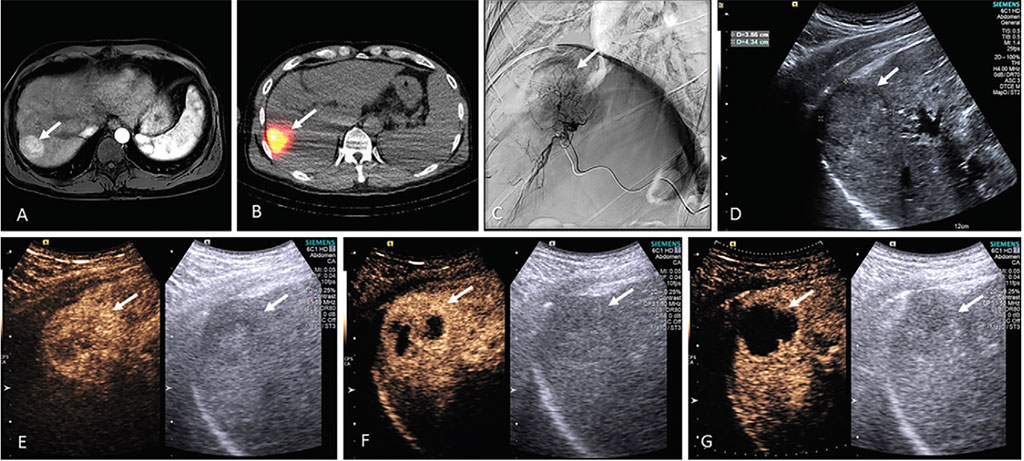Microbubbles Augment RT in Liver Cancer Patients
By MedImaging International staff writers
Posted on 31 Dec 2020
A new study suggests that bursting gas-filled microbubbles using ultrasound waves sensitizes liver tumors to targeted radiation therapy (RT), improving overall survival.Posted on 31 Dec 2020
Researchers at Thomas Jefferson University (TJU; Philadelphia, PA, USA) conducted a pilot study involving 28 patients (mean age 70 years, 17 men) with hepatocellular carcinoma (HCC), who were randomly assigned to trans-arterial radioembolization (TARE), or TARE in conjunction with ultrasound-triggered destruction of microbubbles (UTMD). The researchers evaluated tumor response to each treatment. The safety of UTMD was evaluated by physiologic monitoring, liver function tests, adverse events, and radiopharmaceutical distribution.

Image: Images from a 54-year-old male patient with HCC who underwent TARE with UTMD. The bottom row shows B-mode ultrasound of tumor destruction at different time points after the procedure (Photo courtesy of TJU)
No significant changes in body temperature, heart rate, liver function, or diastolic or systolic pressure before and after UTMD were found. Preliminary efficacy results showed that 93% of tumors had partial to complete response to the TARE+UTMD approach, while only 50% showed a response in the TARE alone group. The researchers also found that patients receiving the combined therapy were also more likely to receive a liver transplant, and also lived longer and required fewer retreatments compared to those receiving TARE alone. The study was published on December 8, 2020, in Radiology.
"This approach has shown to be effective in preclinical studies using animal models of other solid tumors like bladder, prostate, and breast cancer. This is the first work to demonstrate this approach is safe and shows promise in humans with liver cancer, which is very exciting,” said lead author John Eisenbrey, PhD. “This approach could be effective in treating metastatic liver tumors, but also other types of primary cancer. The bubbles themselves can also be engineered to deliver chemotherapy or oxygen as they burst.”
TARE is an experimental therapy for unresectable HCC. The technique involves attaching radioactive Yttrium molecules to tiny glass beads, which are then injected directly into the blood vessels feeding the liver tumor. As healthy liver tissue is mainly perfused by the portal vein, while most liver malignancies derive their blood supply from the hepatic artery, TARE can be selectively administered to the tumors. The microspheres lodge in the small vessels of the tumor (embolization), emitting localized RT to targeted segments, results in tissue necrosis. Damage to healthy liver tissue is thus minimized.
Related Links:
Thomas Jefferson University














